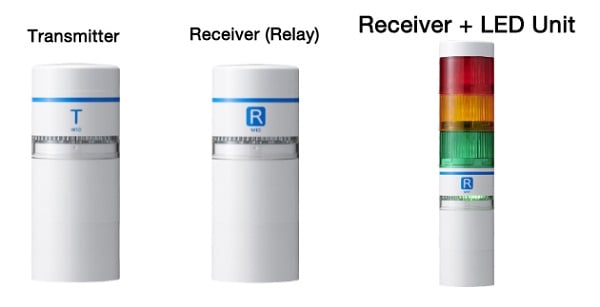Enhance Workplace Efficiency with Patlite’s Bluetooth Stack Lights
Patlite is improving workplace communication and safety with a stack light using Bluetooth control. This system eliminates complex wiring by transmitting signals directly to compatible output devices.
A stack light serves as a visual indicator of system status, typically mounted in multiple spots within a workspace, elevated above the machinery for a clear line-of-sight from a distance.
The new wireless control unit from Patlite offers Bluetooth capability, enabling visual output devices to be in an office or other visible central areas. This ability gives maintenance and engineering personnel instant awareness of system faults or ongoing production without walking to the cell for manual verification. Teams can work more actively and efficiently when they can readily view and understand the operational circumstances.

Assembled Bluetooth Patlite units. Image used courtesy of Patlite
Patlite Wireless Unit’s Bluetooth Capability
The advanced technology within this product enables wireless communication through Long-Range Bluetooth, operating on the 2.4 GHz band. Though this frequency is shared with Wi-Fi networks and other devices, the unique communication protocols allow coexistence without interference. In the unlikely event of a disruption, communication may experience minor delays. However, the optimized design ensures reliable performance in most environments.
The stack light communicates between the transmitter and receiver/repeaters to control connected revolving lights, signal towers, and voice annunciators. The transmitter is the product sending the signals that allow employees to monitor running statuses and system errors remotely. For flexibility, up to three repeaters can be installed to strengthen the wireless connection if needed. If the signal quality is poor due to location or other conditions, the receiver doubles as a repeater, optimizing communication. This wireless system keeps operations running smoothly through reliable, adaptable components.
Optimizing the Patlite Bluetooth Stack Light
To ensure products can communicate with one another, space them no more than 100 meters apart. By adding three repeaters to extend the signal, you can cover distances up to 400 meters. However, obstructions can reduce the effective range. Careful layout planning is required to ensure uninterrupted communication given the characteristics of the unique installation site.
Tips for Stable Bluetooth Connection
- Metal objects such as steel plates, wire mesh, or other noise-generating devices like concrete walls or welding machines can obstruct communication when positioned between the products.
- Nearby wireless devices can interfere with connectivity.
- Strong, constant wireless radio waves from sources like video streaming over Wi-Fi or microwave ovens may disrupt the signal.
- Maintain a maximum of 40 units including transmitters, repeaters, and receivers installed in one building.
- Maintaining a clear, unobstructed line-of-sight (Fresnel zone) between products is crucial for stable communication.

Fresnel zone for wireless communication, according to the distance between nodes. Image used courtesy of Patlite
When you have several units nearby, designating a Group ID for each device prevents unintended connections between groups. This product allows up to 8 units to operate independently in shared space by supporting 8 unique Group IDs. Assign each device its Group ID before powering on and pairing to avoid interference. With individual IDs configured, you can ensure each unit connects to its target during pairing. This simple step eliminates frustration and enables smooth deployment of multiple devices in one area.

Example grouping of Patlite wireless units. Image used courtesy of Patlite
The stack light's integration and expanded signaling capabilities are poised to ease processes and optimize operations across industrial settings. Patlite has demonstrated a commitment to leveraging technology to engineer intuitive solutions that meet the needs of modern workspaces.





